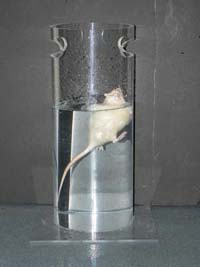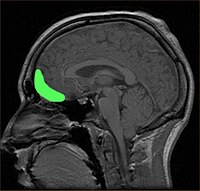
Maternal prenatal stress and depression‐like behavior associated with hippocampal and cortical neuroinflammation in the offspring: An experimental study
Sign Up to like & getrecommendations! Published in 2022 at "International Journal of Developmental Neuroscience"
DOI: 10.1002/jdn.10176
Abstract: Prenatal stress can negatively impact neonatal health, growth, and bonding with the mother. However, molecular basis of these modifications is not completely understood. The aim of this experimental study was to test the hypothesis that… read more here.
Keywords: stress; neuroinflammation; depression; prenatal stress ... See more keywords

Sex and estrous‐phase dependent alterations in depression‐like behavior following mild traumatic brain injury in adolescent rats
Sign Up to like & getrecommendations! Published in 2021 at "Journal of Neuroscience Research"
DOI: 10.1002/jnr.24989
Abstract: Following mild traumatic brain injury (TBI), high school and collegiate‐aged females tend to report more emotional symptoms than males. Adolescent male and female rats (35 days old) were subjected to mild TBI and evaluated for… read more here.
Keywords: like behavior; phase; following mild; injury ... See more keywords

Antidepressant‐like effects of geniposide in chronic unpredictable mild stress‐induced mice by regulating the circ_0008405/miR‐25‐3p/Gata2 and Oip5os1/miR‐25‐3p/Gata2 networks
Sign Up to like & getrecommendations! Published in 2022 at "Phytotherapy Research"
DOI: 10.1002/ptr.7702
Abstract: Evidence exists suggesting the anti‐depressive activities of geniposide (GP), a major compound in Gardenia jasminoides Ellis. Accordingly, the present study attempts to explore the anti‐depressive mechanism of GP in chronic unpredictable mild stress (CUMS)‐induced depression‐like… read more here.
Keywords: mir gata2; oip5os1; gata2; mir ... See more keywords

The Forced Swim Test for Depression-Like Behavior in Rodents.
Sign Up to like & getrecommendations! Published in 2019 at "Methods in molecular biology"
DOI: 10.1007/978-1-4939-8994-2_5
Abstract: The forced swim test assesses learned helplessness, which is a feature of depression-like behavior in rodents. This test has also been used in testing the efficacy of existing and novel antidepressant drugs. It is based… read more here.
Keywords: like behavior; forced swim; swim test; test ... See more keywords

Effect of Vasopressin V1b Receptor Blockade on Activity of the Hypothalamic—Pituitary—Adrenal Axis in Old Monkeys with Depression-Like and Anxious Behavior Subjected to Stress or Injected with Vasopressin
Sign Up to like & getrecommendations! Published in 2018 at "Bulletin of Experimental Biology and Medicine"
DOI: 10.1007/s10517-018-4294-4
Abstract: The effect of selective antagonist of the arginine vasopressin (AVP) V1b receptors on the secretion of ACTH and corticosteroids in response to insulin-induced hypoglycemia and injection of AVP is studied in old Macaca mulatta females… read more here.
Keywords: anxious behavior; v1b; like anxious; depression like ... See more keywords

Porphyromonas gingivalis induces depression via downregulating p75NTR-mediated BDNF maturation in astrocytes
Sign Up to like & getrecommendations! Published in 2019 at "Brain, Behavior, and Immunity"
DOI: 10.1016/j.bbi.2019.07.012
Abstract: Many cross-sectional epidemiological studies have shown the incidence of periodontitis is positive correlated with that of depression. However, their causal relationship and underlying mechanism are largely unknown. Porphyromonas gingivalis (Pg) is the main pathogen for… read more here.
Keywords: depression; p75ntr; bdnf maturation; porphyromonas gingivalis ... See more keywords

Interleukin-6: Its role and mechanisms in rescuing depression-like behaviors in rat models of depression
Sign Up to like & getrecommendations! Published in 2019 at "Brain, Behavior, and Immunity"
DOI: 10.1016/j.bbi.2019.08.002
Abstract: Neuronal injury within specific brain regions is considered a critical risk factor in the pathophysiology of depression. However, the underlying mechanisms of this process, and thus the potential for development of novel therapeutic strategies in… read more here.
Keywords: depression; interleukin role; models depression; like behaviors ... See more keywords

Mifepristone attenuates depression-like changes induced by chronic central administration of interleukin-1β in rats
Sign Up to like & getrecommendations! Published in 2018 at "Behavioural Brain Research"
DOI: 10.1016/j.bbr.2018.03.033
Abstract: HighlightsIL‐1&bgr; increased the levels of pro‐BDNF, but decreased GDNF and GFR&agr;1 in the amygdale.RU486 improved the depression‐like behaviors induced by IL‐1&bgr;.RU486 differently regulated the function of microglia and astrocyte. ABSTRACT Increased proinflammatory cytokines, such as… read more here.
Keywords: depression; gfr agr; bgr; changes induced ... See more keywords

Depression-like symptoms due to Dcf1 deficiency are alleviated by intestinal transplantation of Lactobacillus murine and Lactobacillus reuteri.
Sign Up to like & getrecommendations! Published in 2022 at "Biochemical and biophysical research communications"
DOI: 10.1016/j.bbrc.2022.01.026
Abstract: Depression, characterized by low mood, is a complex mental disorder that is a serious threat to human health. Depression is thought to be caused by a combination of genetic, environmental and psychological factors. However, the… read more here.
Keywords: mice; depression like; like symptoms; lactobacillus murine ... See more keywords

Housing environment influences stress-related hippocampal substrates and depression-like behavior
Sign Up to like & getrecommendations! Published in 2018 at "Brain Research"
DOI: 10.1016/j.brainres.2018.01.021
Abstract: Rats are widely used animal models for biological psychiatry and neuroscience. Laboratory rats are typically housed in impoverished sensory environments. The lack of species-typical sensory environment might radically change the response of individual animals to… read more here.
Keywords: enrichment; like behavior; housing; environment ... See more keywords

Saikosaponin d downregulates microRNA-155 and upregulates FGF2 to improve depression-like behaviors in rats induced by unpredictable chronic mild stress by negatively regulating NF-κB
Sign Up to like & getrecommendations! Published in 2020 at "Brain Research Bulletin"
DOI: 10.1016/j.brainresbull.2020.01.008
Abstract: Saikosaponin d (SSd) is a traditional Chinese medicine that has been widely used in depression treatment. Given the lack of studies demonstrating the underlying mechanism of action of SSd in depression, the presented study was… read more here.
Keywords: behaviors rats; depression; ssd; mir 155 ... See more keywords